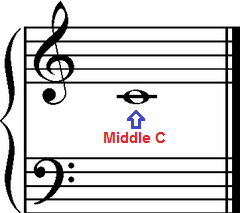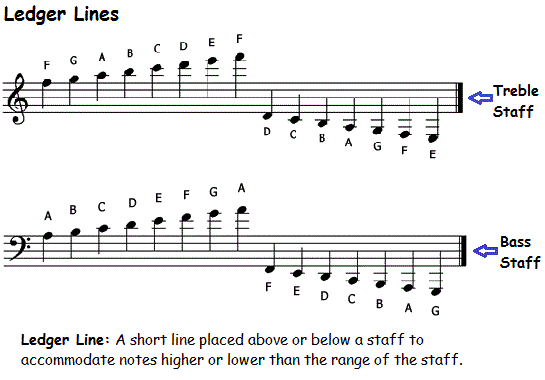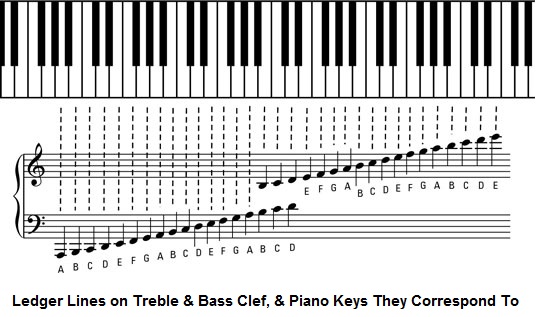This lesson is all about ledger lines. What are they?
First of all, to better understand what they are, we need to know what a staff is. The musical staff is the foundation upon which notes are drawn. It comprises five lines and four spaces. Every line or space on the staff represents a white key on your piano.
My Best Recommendation: Click here for the BEST piano/keyboard course I’ve seen on the Internet.
There are two staves (plural for staff). There’s a treble staff and a bass staff with a treble clef and bass clef, respectively. The notes of the lines on the treble staff from bottom to top are E-G-B-D-F while the notes of the spaces are F-A-C-E. For the bass staff, the notes of the lines from bottom to top are G-B-D-F-A. The notes of the spaces for the bass staff are A-C-E-G. This would give us a total of 9 notes for the treble staff and 9 notes for the bass staff.
We seem to have a problem. Only eighteen notes? What about all the other notes on the piano? After all some keyboards have 61 and 76 keys and a piano has as many as 88 keys.
What seems like a problem is solved by ledger lines. When we run out of room on the staff we add ledger (or leger) lines. These very short lines extend the 5 line, 4 space staff, allowing us to add extra notes. They can be added above or below the treble and bass staff. Those below the staff are the lower notes, while those above are higher notes.
 As a beginner, the first leger line you should learn is middle C. On the grand staff, middle C is located between the treble and bass staff, as shown in the diagram on the right.
As a beginner, the first leger line you should learn is middle C. On the grand staff, middle C is located between the treble and bass staff, as shown in the diagram on the right.
On piano, if middle C is written with a ledger line below the treble staff, you play it with your right hand. If the line is above the bass staff you play it with your left hand. Middle C is located in the middle of your piano.
Here is a diagram showing several ledger lines:
As a beginner, you shouldn’t be too concerned about the very high and low ones. Your focus should be mainly on the lines and spaces on the staff and middle C. Then you gradually add leger lines as you progress. Usually, you wouldn’t use more than two lines. Learning happens one step at a time and there’s no need to rush.
It may look difficult to understand at first glance, but it’s very easy to name the notes. All you have to do is to keep moving up or down the musical alphabet, A-B-C-D-E-F-G.
How To Avoid Multiple Ledger Lines
This is where things get a little more complicated. If you’re a beginner, don’t let this bother you too much. It will take you a lot of time before you ever reach this level. But it’s good to know nonetheless so that you see the bigger picture.
In piano music, multiple ledger lines can make sight-reading difficult. To solve this problem they are often bypassed and other methods are used. These methods include the octave commands, 8va, 15ma, 8vb and 15mb.
8va means that a note or section will be played an octave higher than written, whole 15ma means that you must play two octaves higher.
Let’s say you’re required to play the last C note on an 88-key piano. This note is C8. Instead of writing this note on the 9th leger line above the treble staff, 15ma can be used above C6, making it easy to identify the note.
Let’s say you’re required to play the lowest note on an 88-key piano. This note is A0 and can be written just under the sixth leger line below the bass staff. Instead of adding so many leger lines, it could be written with 15mb on A2 or 8vb on A1.
Another way to avoid ledger lines for very low notes on the treble staff is to invade the bass staff. Simply write the notes in the bass staff.
Sometimes, these lines are avoided by adding a temporary G-clef on the bass staff or a temporary F-clef on the treble staff.